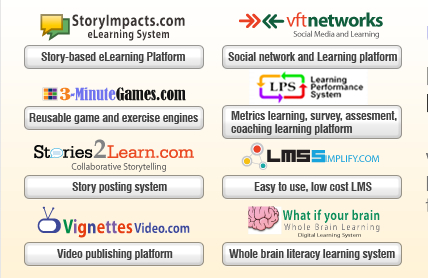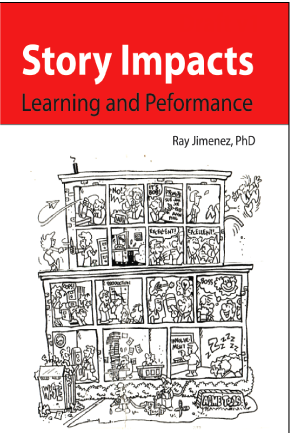Cross-posted in my KatharineHansenPdD.com blog about online teaching..
A major reason that I’ve been delinquent in getting A Storied Career back on track is that I have been trying to build a new career in online teaching. Here’s a post that combines my passion for applied storytelling with my emerging career.
As I embark on a career in online teaching, I know I will integrate my passion of the last eight years, applied storytelling, into my courses. In fact, I already have. In the enhancements I added to my Principles of Management course for StraighterLine, I integrated storied videos, both those I created myself and others I found from other sources.
I’m not just using storytelling because I love it, of course, but because stories promote learning. As Roger Courville points out, “the primary research all agrees that story help us more readily comprehend and retain information.”
In this post, I’m listing some concepts and resources I’ve come across in my early efforts to incorporate story with eLearning. The list is by no means all-ecompassing but represents a microcosm of a vast sea of available material.
Vignettes Learning: A generous and remarkable resource. I’ve blogged  before about Vignettes and its founder Dr. Ray Jimenez (this post has funky formatting because most of my older posts have not yet been carried over to my blog’s newer WordPress theme). As the graphic at right shows, Vignettes offers a huge variety of resources for those interested in story- and scenario-based learning. Dr. Jimenez and his colleagues offers many free webinars (including one tomorrow – April 26, “Truths and Lies: Keeping Authenticity in eLearning Stories“) with free handouts whether you attend the webinar or not, as well as publications, such as Story Impacts, which offers eLearning interactive mini-stories and source files. Still another amazing offering is 10 Models of Interactive Stories.
before about Vignettes and its founder Dr. Ray Jimenez (this post has funky formatting because most of my older posts have not yet been carried over to my blog’s newer WordPress theme). As the graphic at right shows, Vignettes offers a huge variety of resources for those interested in story- and scenario-based learning. Dr. Jimenez and his colleagues offers many free webinars (including one tomorrow – April 26, “Truths and Lies: Keeping Authenticity in eLearning Stories“) with free handouts whether you attend the webinar or not, as well as publications, such as Story Impacts, which offers eLearning interactive mini-stories and source files. Still another amazing offering is 10 Models of Interactive Stories.
 Interactivity: Dr. Jimenez also offers a blog, in which one of his recent posts stresses the importance for learning of stories that are interactive. “My interest in Story-Based eLearning Design,” he writes, “led me to conclude that interactive stories are valuable agents in transferring knowledge into applications.” He cites the article, Storytelling as a Link between Formal Knowledge and Actual Performance in a Critical Transformative Design Environment, by Paul Oord and Cecile Crutzen, in which the authors note: “Telling about their own experiences, reading and reflecting on experiences of other students in a learning environment could broaden their view on the use of technology in future design processes and in other interaction communities.”
Interactivity: Dr. Jimenez also offers a blog, in which one of his recent posts stresses the importance for learning of stories that are interactive. “My interest in Story-Based eLearning Design,” he writes, “led me to conclude that interactive stories are valuable agents in transferring knowledge into applications.” He cites the article, Storytelling as a Link between Formal Knowledge and Actual Performance in a Critical Transformative Design Environment, by Paul Oord and Cecile Crutzen, in which the authors note: “Telling about their own experiences, reading and reflecting on experiences of other students in a learning environment could broaden their view on the use of technology in future design processes and in other interaction communities.”
In ‘Story Editing’ as a Technique for Improving eLearning notes that his decades of experience as an eLearning developer have enabled him “to observe how people react to interactive teaching methods. By simulating real-life scenarios in our learning modules, learners experience the learning process with impact. The learning strategy of Story-Based eLearning Design places our participants in a simulated environment that mirrors real-life situations.” He point to Vignettes’ interactive eLearning videos (which I’ve used in my course designs) that “simulate actual life scenarios, the participants experience the urgency of the situation and discover their responses.” (Dr. Jimenez cites “story-editing” as a term set forth by author Timothy D. Wilson that refers to giving people “information that suggests a new way of interpreting their situation.”)
Self-disclosure stories. Taking the idea of sharing student experiences a step further, David Lee cites Peter Bregman, who “by sharing his inner world, including his fears, insecurities, and human imperfections, … makes it safe for people to do the same.” To paraphrase Lee in the context of teaching and learning, Bregman, by sharing his internal world along with his missteps, he invites the learner to vicariously do the same. So, here we’re seeing the idea of the instructor modeling the sharing of experience stories to encourage students to do the same. Lee’s post lists six examples of self-discolosure stories that, in this case an instructor, can use. An especially effective kind for teachers is the “I blew it” story, which “enables [him or her] to be a powerful teacher while at the same time, not coming across as a Know-It-All ‘I’m the guru and you’re not’ way that some authorities adopt.”
Collecting, Curating, and Telling Stories. In a webinar I attended not long ago, Roger Courville discussed the power of story in the virtual classroom, and included guidance on finding stories and integrating them into an online-learning experience. In 10 tips for storytelling in the virtual classroom – part one and part two, Courville talks about using stories to illustrate points, how to curate stories in light of aspects unique to the virtual classroom, and how to practice stories for effective delivery. Part two also contains a nice list of resources about storytelling.
Tools for storytelling. As I mentioned, I found myself delving into creating video stories – both talking-head versions and stories evolving from slideshows – for my new Principles of Management course for StraighterLine. An absolute flood of tools for creating multimedia stories grows every day, and my work barely even scratched the surface. An article that also just scratches the surface (focusing on iPad apps) is Digital Storytelling and Stories with the iPad, which not only suggests apps, but also takes the instructor through the steps for creating stories this way.
Storyboarding is another aspect of creating storied multimedia learning experiences, and educator Chiara Ojeda of Tweak My Slides offers a wonderfully illustrative tutorial on four ways of organizing slides for storied presentations.
I’m excited to know that as I seek to add storied approaches to my online teaching, I can rely on a ton of excellent resources. Check them out!
